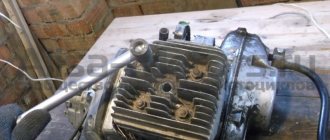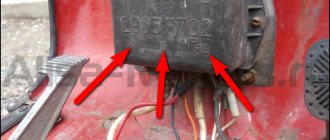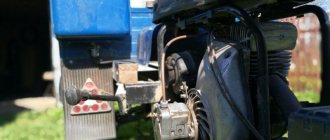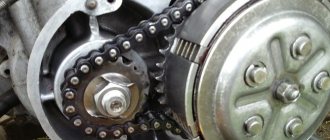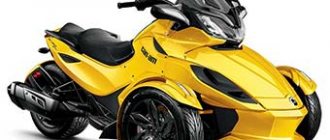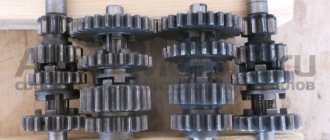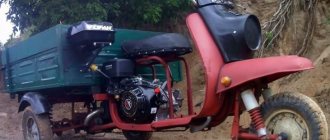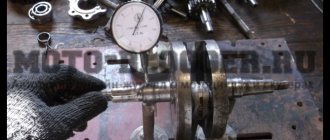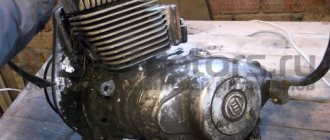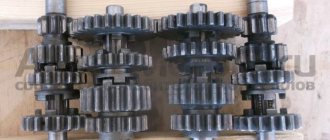Tula electric truck Ant - now also for the police?
“What a face you have, Sharapov!” — I want to exclaim, looking at the Ant electric truck produced by Tulamashzavod. This plant, known for its weapons (automatic cannons for armored vehicles and helicopters, naval artillery mounts, anti-aircraft guns, etc.), even at the Army 2019 exhibition showed the “fruit of conversion” - the Ant mini-truck with electric drive.
Its basic load capacity is one ton, the drive is either only from batteries, or also from an on-board diesel generator, the Chinese electric motor develops only 5 kW, and the batteries... Do you think lithium-ion? No matter how it is, they are ordinary lead-acid ones that produce a voltage of 48 V.
In the fiberglass cabin, made in Vladimir, there is a steering wheel from a Lada of the tenth family. The power reserve is not officially reported, but it seems that the car should travel up to 90 km without a load, and its maximum speed is only 22 km/h.
It’s interesting that Tula residents position Ant as the heir to the scooter of the same name. By the way, I rode a little on such a scooter last summer along a field road just outside Tula... A noble device!
At the same time, the new truck is officially called an “in-plant vehicle” - it is an electric vehicle that does not require license plates when used in closed areas. By the way, there are plenty of them in Europe: similar electric cars are regularly demonstrated at an exhibition in Lyon, France.
I thought that Ant's revival would end with prototypes, but in May last year it became known that an electric truck could be bought. There is even an Internet configurator, judging by which, the plant can change almost all indicators: body length (1.86-2.86 m), load capacity (1-2 tons), power (4-10 kW), battery capacity (165-340 Ah), and the version with the most capacious batteries will supposedly be able to travel up to 340 km, which is hard to believe.
The price tag on the website again supposedly starts at 787,000 rubles, but it is further stated that the basic equipment without an awning, stove and winter tires costs 1,150,000 rubles, but it is stated above that the price when ordering online is 1.2 million rubles. If you add a little more, you can take Gazelle Next!
And we managed to catch two such cars on the Simferopol highway. They were transported on tow trucks, not from Tula, but in its direction - apparently, the trucks were returning from testing or certification. Unlike the prototype, these cars have lost sliding windows on the sides (but there is now such a window in the back!), and the bodies are different, but otherwise everything is the same, and the battery voltage is indicated on the electrical equipment under the body, 48 V.
The most curious thing is that the cab of one of the Ants has police colors on it! From this we can assume that the appearance of such “electric cops”, only probably with different bodies, is possible in pedestrian and other environmentally friendly areas.
Electric car "Ant": new, but already beloved
President of the Russian Federation Vladimir Putin has set large-scale tasks for enterprises of the military-industrial complex to increase the production of civilian products. In demand, competitive both within the country and in world markets. According to the president, by 2025 the share of civilian products in total production should reach 30%. In the joint-stock company, which ensures the defense capability of our Motherland with military products, this mark has already been reached.
Own production is established at numerous subsidiaries created in the joint-stock company. Motor-cultivators and walk-behind tractors, machining centers and axial monolithic carbide tools - all products are distinguished by high Russian quality and world-class efficiency and durability.
Recently, Tulamashzavod became the copyright holder of new key patents protecting the appearance and main structural elements of the Ant electric truck. Under this name, which is a trademark of the enterprise, from 1957 to 1997 the plant produced the legendary cargo scooter. We became interested - has its production really been resumed? As it turned out, the good old three-wheeled friend is no longer as in demand as before, and Tulamashzavod presented potential buyers with a fundamentally new vehicle.
The Tula “Ant” was at one time in great demand both in the countryside and among city dwellers - owners of summer cottages. Today, if you can still find such equipment, manufactured more than 30 years ago, on the country roads of Russia and neighboring countries, then in Europe and the USA it has been replaced by small, maneuverable trucks and cars with trailers.
New times pose new challenges for machine builders. Requirements for the environmental friendliness of vehicles are coming to the fore today. It's no secret that Tula is among the leaders in the number of cancer and cardiovascular diseases per capita. One of the reasons, in addition to the large number of enterprises, is the dense flow of personal, passenger and cargo transport, the exhaust gases of which we are all forced to breathe every day.
The situation needs to change. Responding to the challenges of the time, AK Tulamashzavod JSC presented a new type of vehicle in the spring of 2021. It is only related to the legendary cargo scooter “Ant” by its name and manufacturer.
Initially, the new “Ant” was created as a vehicle for intra-factory freight transportation. The fundamental novelty of the development in comparison with domestic and foreign analogues is the use of a hybrid drive in the vehicle - an electric drive from a diesel generator set (DGS) produced by Tulamashzavod and/or from a battery. A “lightweight” civilian modification of the diesel generator set was developed especially for Ant, which is used in armored vehicles and, naturally, has high technical and operational performance. Vehicles differ in carrying capacity (1 and 2 tons); there are models with an increased wheelbase (the length of the loading platform). The Ant has four wheels, a comfortable enclosed cockpit and automotive controls. The length, width and height of the machine in the basic configuration are 3500, 1500 and 2500 mm, respectively. The range on one charge depends on the battery capacity and varies from 70 to 180 km.
The new electric vehicle is also in demand at agricultural enterprises. "Ant" based on the mechanization of TulamashAgro LLC.
In 2021, the first trucks began work at Tulamashzavod, and have proven themselves well at enterprises in Tula and other cities: Kovrov, Samara, Kolomna.
In the summer of this year, a batch of ten vehicles with a carrying capacity of 2 tons with an extended frame and an awning was purchased by Mosgortrans, an operator of ground bus transportation in Moscow. The “Ants” set off for the Moscow river port on the eve of its opening after repairs. The supply of electric vehicles to the capital's river workers was the result of an agreement with the Trading House, which is a long-time partner of the Moscow City Hall. Experts highly appreciated the technical characteristics and quality of the compact, convenient machines.
Tula "Ants" are sent to the Moscow river port.
The Northern River Station in Moscow, sometimes called the “port of five seas,” opened after restoration on City Day. The building was restored to its historical appearance, and the promenade area on the embankment was improved. The modern embankment is now equipped with a system for supplying electricity to arriving ships so that this part of the city remains an environmentally friendly area, despite the movement of steamships.
“Ants” powered by electrical energy fit perfectly into the concept of caring for the environment.
According to the agreement, Tulamash-Tarpan assumed obligations for their warranty and post-warranty service. This batch, consisting of ten vehicles, became the first sign, a real breakthrough on the Moscow market. In a city where great attention is paid to ecology, Tula electric cars are really in demand.
“Ants” are also used in agricultural enterprises.
– We use two electric vehicles based on mechanization. “We are very pleased,” Pavel Yangulov, deputy chief engineer of TulamashAgro LLC, shared his opinion. – Compared to domestic models with which I had to deal before, the Ants are easy to control, they are distinguished by a soft ride and a spacious cabin. Pleasant little things are also pleasing, for example, electric wipers. The cars are maneuverable, the battery charge lasts for two weeks.
Over the course of several months of operation, the Ant charmed the staff of the Hunting Season hotel, located in the Tver region.
“We purchased three cars, primarily for landscaping,” said Tatyana Konstantinovskaya. – We transport brush cutters, bags of reagents and much more. “Ants” pleasantly surprised us with its noiselessness, because it is very important for us to give our guests the opportunity to relax in silence. I would also like to note the ease of operation, high-quality ventilation and heating of the cabin, and how well they move across the field.
The new “Ant” becomes a reliable assistant in business - it is indispensable in warehouses, logistics centers, airports, sanatoriums, parks, housing and communal services organizations - primarily where high demands are placed on the environmental friendliness of transport. High maneuverability allows the Ant to move both indoors and in open areas. Depending on the customer’s wishes, electric vehicles can be supplied in several configurations, with batteries of different capacities and engines of different power.
The equipment of the electric vehicle is agreed in advance with the customer.
Cabin options have been developed: fiberglass with and without doors, cabriolet cab, frame cab in several versions, cabs with additional options. Various versions of the cargo platform have been developed: with sides, without sides, with an awning, with a van. Accordingly, the price of a compact and easily driven vehicle varies from 700 thousand to 1 million rubles or more, which is similar to the prices of Russian manufacturers and distinguishes it favorably from foreign analogues with similar technical characteristics. Over time, in the event of a transition to large-scale production, Ant may become even more affordable.
You can get to know the new brainchild of Tulamashzavod better on the official websites of the enterprise tulamash.ru and tarpanelectro.ru.
GTS-1 – cargo scooter with cabin
The production of a three-wheeled light-duty vehicle has been resumed - the GTS-1 cargo tricycle with a cabin, the prototype of which is the domestic cargo scooter "Ant", well known to everyone in the USSR and Russia. The GTS-1 cargo vehicle has passed all factory tests and is intended for transporting various cargoes across construction sites, factories, enterprises, industrial zones and in rural areas without the right to drive on public roads.
The only thing better than a cargo scooter is a scooter with a cabin. It has a number of features that explain the enormous popularity of this type of transport. For example, the carrying capacity of such a three-wheeled “truck” is a record 800 kg, and two people – a driver and a passenger – can be in its cabin at the same time, including while driving. The maximum speed that a cargo tricycle with a cabin can reach is 60 km/h or more.
The GTS-1 cargo scooter will replace 13 horses - this is exactly the power of its gasoline engine, which is started using an electric starter. It is controlled by a steering wheel just like a car. It has a reliable steel frame, and the body is made of metal and equipped with three folding sides, as well as a tipping mechanism for the entire body. To increase the volume of the cargo compartment, it is enough to install a canvas or metal awning.
The high ground clearance of 22 cm allows you to safely ride a tricycle not only on comfortable city roads, but also on dirt roads in rural areas. Fuel consumption is 5.5 liters per 100 km, which means that with a gas tank volume of 25 liters, one full refueling is enough to travel about 500 km. To increase traffic safety, cargo scooters with cabs are equipped with sensitive drum-type brake mechanisms and rear-view mirrors.
It is worth noting that three-wheeled cargo motorcycles, scooters and scooters in Moscow are best used inside industrial zones, enterprises, construction sites or in rural areas. It is not recommended to drive it on public roads and on the streets of cities of the Russian Federation. But usually this is not required - such transport is widely used by private owners to transport goods over short distances, as a rule, in remote towns and villages.
The sale of cargo three-wheelers with a cabin was resumed not long ago. Some time ago they were very difficult to acquire. Today, anyone can buy a cargo scooter with or without a cab. A very favorable price, a wide range of colors, reliability of the equipment during its daily operation, simple maintenance and inexpensive repairs make cargo tricycles an extremely popular vehicle in all countries, without exception.
The manufacturer provides a guarantee for vehicles of this kind, which is valid for 1 year, however, numerous reviews indicate that such trikes last 5-10 years without serious complaints. All that is required of the owner is to carry out maintenance of the tricycle on time. In the showcase of our online store you can choose and buy a cargo scooter with a GTS-1 cab, painted in white, grey, blue and red.
“Ant” of the 21st century: ACT-Bumblebee - An interesting and beloved model by many
Many people remember the Ant scooter, produced from the early 60s to the mid-90s at the Tula plant, used for transporting light-duty cargo.
Since that time, nothing resembling this vehicle has appeared in our country, although its implementation according to a three-wheeled design with a simplified design and a motorcycle engine as a power plant became the key to reduced operating costs and low cost.
Update . In the current economy, the advantages of “Ant” are again in demand. It is not surprising that a decision was made to revive such a useful vehicle, although it had already been forgotten. In the city of St. Petersburg, a presentation of a prototype of a new model of a tricycle, that is, a vehicle with three wheels, was held; it was called “Bumblebee”.
The idea of creating a car was quite simple. Similar to its predecessor, the Ant, the Bumblebee also has a three-wheeled design. Its distinctive feature is that it can be used throughout the year. This became possible thanks to the installation of a closed cabin with heating. It can accommodate two people instead of one.
Technical specifications . Under the cabin there is a motorcycle engine with a volume similar to the power plant of its predecessor - 200 cc. cm. Its increased power becomes completely justified, since the fully loaded weight of the “Bumblebee” reaches 430 kg, mainly due to the installation of a new cabin design. In addition, it is capable of carrying about a ton of payload, which is three times more than was previously possible.
As before, the plant in Saransk was chosen as the place for the production of the new tricycle model, where work on welding the frame and cabin frame will be carried out, as well as final assembly.
Despite the fact that a large number of similar Chinese-made vehicles became the model for the development of the Bumblebee, it was able to be subjected to quite serious localization. The list of domestically manufactured parts includes a rear axle from a VAZ classic, leaf spring suspension, wheels with tires, driveshaft, radiator, glass, heater, braking mechanisms and all electrical appliances, including headlights.
Parts of the external trim of the cabin and dashboard are made of plastic, produced at a plant near Nizhny Novgorod, specializing in such products. The line of power plants is produced in China. A single-cylinder water-cooled engine with a power of 17 hp, as well as an integrated gearbox, are produced under the Lifan brand.
This is not at all surprising, since there is no suitable power plant in domestic lines, and in China, until recently, they were produced in huge quantities. In addition, Chinese manufacturers supply the pedal assembly, steering parts and front suspension with wheel forks.
Conclusion. The cost of such a tricycle is quite moderate - for a model with an on-board platform measuring 2 by 1.5 meters they will ask about 250 thousand rubles, with a van with a volume of 4 cubic meters - 50 thousand more. The company plans to produce the stated one hundred units per month, since there will certainly be demand.
Chita, Belka, Ant: Soviet rare passenger cars
| Yuri Dolmatovsky with his rear-engine carriage brainchild NAMI-013 |
The main proponent of the carriage layout was Yuri Aaronovich Dolmatovsky, a candidate of technical sciences, a talented engineer and artist, founder and theorist of the school of Soviet automobile design, a famous popular writer and journalist. A long time ago, several generations of boys were brought up on the books and articles of Dolmatovsky, who tried to inspire us with his great passion for cars and support his “comrades in mania.”
The birth and death of “Chita”: the first Soviet trailer NAMI-013
Having completed the development of cargo bodies and trailer toilets, in 1949 Yuri Dolmatovsky, head of the body design bureau of the Scientific Automotive Institute (NAMI), began to fulfill his cherished dream - the creation of avant-garde cars with a carriage layout, which were then called trambuses. Thus was born the idea of the revolutionary car NAMI-013, which was developed by engineer Konstantin Zeyvang and designer Vladimir Aryamov.
| Aryamov’s sketch is a squat car with soft aerodynamic shapes and unusual proportions. |
| Dolmatovsky's project - NAMI-013 with strict forms, massive bumpers and a pronounced rear engine compartment |
Even before the birth of the future car, debates flared up in NAMI about the feasibility of a rear-engine design and the possibility of giving the car beautiful outlines. To imagine how it would be perceived in “natural conditions,” a life-size mock-up of NAMI-013 was built, and to make it look like conventional production cars, the silhouette of an ordinary hooded car was painted on its body, camouflaging all the signs of a rear-mounted engine.
| A model of the NAMI-013 car with a painted hood body “to assess the possibility of its operation.” 1949 |
The first unfinished version of NAMI-013 with a tubular truss instead of a body was ready in December 1950, but crashed to the ground when overloaded, and then it took another year and a half to repair and improve it. During this time, they managed to assemble and remake three versions of the same car, differing in the design of the body, interior with three rows of seats for 6–7 people and the placement of the radiator of the engine cooling system.
| The first version of NAMI-013 with characteristic round air intake openings | |
In 1951, the first version of the NAMI-013 load-bearing body was manufactured at the institute’s pilot plant. In June 1952 it was fully equipped, and the following year the prototype entered testing. Its driver's seat was moved forward and fit between the front wheel wells, and the power unit was located at the rear outside the wheelbase, which created the car's characteristic aerodynamic shape. The unusual streamlined body had doorways that extended onto the roof, but the upper door hinges were installed on the outside, and the side windows were made sliding.
| The first version of NAMI-013 with an aerodynamic body is being tested |
| The second version of NAMI-013 with side moldings and lightweight bumpers |
In the rear compartment of NAMI-013 there was an experimental NAMI-013-D4 engine with a power of 63.5 hp. with two carburetors, created on the basis of the engine from the Pobeda passenger car and worked with the first experimental hydromechanical transmission in the USSR NAMI-DK. In his memoirs, Dolmatovsky wrote: “She especially touched us: she acted as if nothing had happened, despite all our anxieties and fears. We were very proud of her." But finding a place for the radiator has become a serious problem. Again, a word to Dolmatovsky: “Finally, we sawed it in half and placed the resulting two narrow halves in a massive buffer with an electric fan and dampers...”
The final third version of NAMI-013 with two radiators inside the bumper
The car used independent suspension and discless wheels with 13-inch tires. Its wheelbase was 2.4 meters, the maximum speed with a full load was 113 km/h.
| Layout diagram of the main units and components on the NAMI-013 machine of the third series |
The appearance of NAMI-013 coincided with the demonstration in the USSR of the American film “Tarzan”, in which a monkey named Chita “starred”. Neighborhood boys noticed the resemblance of an unusual car with a wide “mouth” in the bumper, convex headlights and a sloping “forehead”. Since then, all races were accompanied by shouts: “Guys, Chita is coming!” And soon this nickname took root.
| The front of the third version really resembled the face of a monkey | Rear engine compartment with modified Pobedovsky engine |
The main test results concerned the comparison of “Chita” with “Pobeda” and ZIM vehicles and in most cases were in favor of NAMI-013.
| Comparative tests of NAMI-013 of the second version with the representative car GAZ-12 ZIM |
| Road tests of the latest version of NAMI-013 with the conventional Pobeda M-20 |
And yet, there were many more important negative qualities: insufficient safety for the driver and front passenger, handicraft design, too complex transmission, high cost of an unusual “toy”, etc. In its conclusion, the acceptance committee stated: “The shortcomings of the car cannot be eliminated.” .
| Fully modified and tested NAMI-013 (photo from NAMI's final report) |
In 1954, “Chita” was written off and dismantled, the body was cut with an autogen and sold for scrap, although its creators for a long time assessed their car as a huge breakthrough in the Soviet automotive industry, ahead of its time.
“Squirrel” frozen in a jump: minicar IMZ-NAMI A50
Having failed with “Chita”, in 1955 Yuri Dolmatovsky switched to a new exciting idea of creating a mass-produced, inexpensive microcar “Belka” with a carriage layout. In its brief summary, “Belka” is a smaller “Chita”, the engine is taken from a motorcycle, but equipped with a cooling fan and an electric starter and mounted on rubber cushions in the bottom of the supporting body...”
| Promising minicar IMZ-NAMI A50 “Belka” without the left side door |
| Diagram of the closed version of the rear-engine Belka car |
This time, all work on the design and organization of production of two versions of the Belka was carried out at the Irbit Motorcycle Plant (IMZ) under the leadership of Deputy Chief Designer Fedor Reppikh and bore the same marking IMZ-NAMI A50. For the first two cars, Vladimir Aryamov developed an original end door with a hemispherical windshield, which, together with an articulated steering column, tilted forward for entry and exit, and not to the side, as, for example, in the BMW-Isetta. The front seats were made bowl-shaped, and the right hinged door served as access to the rear sofa.
| On the right side, the Belka was distinguished by the installation of one swing door | Original front hinged door designed by Aryamov |
The cars were assembled in Irbit by November 7, 1955, and then they were sent in a mail car to Moscow. They had a wheelbase of 1.6 meters, a length of 3.3 meters, weighed 640 kg and reached a speed of 80 km/h.
In 1956, design artist Eduard Molchanov developed a rural version of the Belka with a tilt body without doors, a folding flat windshield frame and a spare wheel on the front panel between the headlights. The seats did not have springs: their functions were performed by rubber bands stretched over the seat frame. Unlike the first version, the car weighed 575 kg and reached 76 km/h. When she was presented to N.S. Khrushchev, he was indescribably delighted, which in fact turned out to be blatant hypocrisy.
| Agricultural "Belka" with a characteristic spare wheel on the front panel of the body |
| Rear-engine "Belka" with four double seats and a folded top |
| Off-road testing of the agricultural "Squirrel" at NAMI | Yuri Dolmatovsky driving an open "Belka" in the yard of NAMI |
At the rear of both Squirrels there was a 746 cc boxer engine with 20 horsepower and a three-speed gearbox. The holes for air flow were located in the engine compartment lid and were equipped with controlled flaps. The independent wishbone suspension of the 10-inch wheels consisted of springs with telescopic shock absorbers, and the brakes were hydraulically actuated.
| Test drive of the open Belka in city traffic in the center of Moscow. August 1955 |
| Experimental run of the Soviet "Squirrels". Photo from the British magazine The Motor dated June 20, 1956 |
In the meantime, three more cars were built at IMZ and they planned to produce up to 20 thousand “Squirrels” per year, NAMI began assembling two more “Squirrels”, and Dolmatovsky amused himself with a future family of light and inexpensive multi-purpose vehicles. And everything would have gone according to plan, but then Nikita Sergeevich again intervened in automotive affairs, actively pushing the serial production of a completely different car in Zaporozhye... What happened next does not need to be explained to experts in the history of the Soviet automobile industry.
Microcar "Ant"
In October 1966, at the celebration of Motorist Day in Moscow, the attention of spectators was attracted by the original compact car “Ant” with a forward driver’s seat, which was designed and built by engineer Oleg Ivchenko. One of its features was a four-seater body of a laconic shape without complex surfaces, assembled according to the drawings of Eduard Molchanov. It was made of plywood covered with fabric and installed on a welded frame, to which the tubular subframes of the main units were connected, including independent suspensions and axles from Serpukhov motorcycle strollers.
| The Ant microcar is a successful union of the original talents of an engineer and an artist |
At the rear of the “Ant” there was a two-cylinder 344 cc engine with 14 horsepower from the Czechoslovakian Jawa motorcycle, for cooling of which air was supplied through channels between the outer and inner linings. The windshield was borrowed from Moskvich, the instrument panel was mounted on a steering column with one spoke. "Ant" turned out to be the only development of "Belka", but it was not possible to organize its release in Serpukhov.
| The original carriage minivan “Druzhba” reached a speed of 130 km/h. 1978 |
One of the first Soviet minivans, Druzhba, which was assembled by Moscow worker Nikolai Davydov, can be considered the closest relative of carriage-type cars. The homemade car was based on a serial VAZ-2101 passenger car with a rear-mounted engine and an angular, transformable five-seater body.
Shouldn't we outdo the British Mini? - failed "Maxi"
In 1967, having completed work on the legendary taxi (we will talk about it later), Dolmatovsky took on the project of a high-speed Maxi passenger car for mass use in large cities. At that time, he headed the Department of Artistic Design of Transport Vehicles of the All-Union Scientific Research Institute of Technical Aesthetics (VNIITE) and recklessly decided to pit his “revolutionary” Maxi against the popular British front-wheel drive car Mini.
| Project “Maxi” - watercolor by Eduard Molchanov from the series “Cars developed at VNIITE” |
The project of a streamlined rear-engine car with a fiberglass body and units from the ZAZ-965A was developed by Aryamov and Molchanov with the participation of designer Lev Kuzmichev. It was possible to achieve an increase in interior volume by turning the front seats towards the doorway and installing two sliding doors, which made it possible to get out of the car in the tightest places. The original body part was a massive rear pillar, which played the role of a safety arch and an air duct for cooling the power unit.
1 / 3
2 / 3
3 / 3
The Maxi was equipped with a 900 cc air-cooled V4 engine producing 30 hp, a manual four-speed gearbox and independent suspension on 10-inch wheels. The wheelbase was slightly more than two meters, the curb weight was 650 kg, and the maximum speed was 120 km/h.
| The unusual and attractive “Maxi” returns from another presentation |
The only sample of “Maxi” was assembled in the pilot production facility of VNIITE at VDNKh USSR. The very first tests proved that the vehicle was unsuitable for operation in Soviet road conditions, and when the mass production of Zaporozhets was launched, its further modernization turned out to be impractical. "Maxi" remained unclaimed. It was presented to a circle of motorists from Khimki, where it ceased to exist.
The title photo shows the legendary but unsuccessful passenger car of the NAMI-013 wagon layout designed by Yuri Dolmatovsky
Only authentic photographs and drawings are used in the article.
"Ant"
A home-made carriage-type car, designed and built by designers Molchanov and Ivchenko, was named “Ant” . The car was driven by an engine from a YAVA-354 motorcycle, located in the rear of the body. When making the body, the creators of the Ant used 45 mm diameter pipes for the frame, plywood for the sides and sheet steel for the front part. From the SZA motorized stroller, the car received independent suspension on all wheels.
One of the creators of the car, O. Ivchenko, said the following about his car: “Ant” was made according to the drawings of the artist E. Molchanov, whose idea I really liked. The artist's work is the first stage. The second stage is the selection of units. And finally, design and manufacturing.”
The car chassis consists of separate components: a front panel with controls, a front axle, a frame and a rear axle to which the power unit frame is attached. This design made it easier to manufacture the chassis. The body frame is welded to the frame connecting the front and rear axles: a three-dimensional structure made of steel corners measuring 25x25x3 mm. The frame is covered with eight-millimeter plywood, which is secured with countersunk screws. The threads for the screws are cut into the steel corners of the frame. The result was a monocoque body. The fabric is glued to the plywood using casein glue. The basis of the wind window frame is a pipe with a diameter of 20 mm, curved in the shape of the letter “P” and curved along the contour of the glass, which was borrowed from the Moskvich-407 car. The lower part of the frame is made of sheet steel 0.8 mm thick.
The instrument panel is made of sheet steel and is mounted on the steering column. It contains control instruments, a central light switch, an ignition switch, a turn signal switch, etc. The engine compartment lid and the tray that covers the engine from below are made of sheet metal. Luggage compartments are located under the front and rear seats.
The front axle - from a motorized stroller - is equipped with brakes. The front axle of a motorized stroller is also used for the rear axle. Instead of pins, modified rear suspension hubs of a motorized stroller are attached to its suspension arms. Due to the increase in the track of the rear wheels, the axle shafts are lengthened. To attach the power unit frame, made of pipes, brackets are welded to the rear axle beams.
The engine, differential and rear axle are a single unit that can be easily removed if necessary. The differential was taken from a motorized stroller with minor modifications, the engine was from a YAVA-350 motorcycle, and the DS-1 dynostarter was from a Tula scooter, installed instead of a generator. For this purpose, a transition roller is made, which has an inner conical part for the output end of the engine shaft and an outer part connected by a dyno starter. A bearing is pressed onto the transition shaft, which partially relieves the load on the main bearing. The impeller and the cam of the breaker-distributor are attached to the dynostarter. The distributor-distributor from the YAVA-350 engine is attached to the engine blower casing made of steel sheet. Despite the intense operating conditions of the engine, the airflow system performed satisfactorily. The Ant, designed for four people, has proven itself well on roads with different surfaces. The car is stable on roads, quite dynamic and, when driving at full load, reaches speeds of up to 70 km/h.
The miniature Ant truck was assembled in one copy. It was exhibited in Moscow, acted in films, took part in all parades of home-made cars and was even used as a truck for transporting confectionery products. But his fate was sad: one rainy winter, the roof of the garage in which he was standing collapsed, burying his homemade product. Only a few details remain - a steering wheel, an emblem, maybe something else. The owner kept only the emblem on the front.
Pony roller: getting acquainted with a cargo tricycle from Nizhny Novgorod
Three years ago we talked about the “bumblebee roller” - a Shmel cargo tricycle from Saransk. That project has already been cancelled, but the Forward company from Nizhny Novgorod decided to pick up the fallen banner of cargo tricyclism. I visited there and took a ride on a vehicle painted by the Pony Express courier company.
The laurels of the three-wheeled scooter Ant haunt Russian equipment manufacturers! First the Bumblebee with a gasoline engine from China, now the Forward, whose engine is also Chinese, but electric. The Nizhny Novgorod atelier Forward specializes in fiberglass products: they produce masks for Vityaz trams, cabins for Ivolga electric trains, superstructures for Gazelles and Lawns, and even entire medical road trains. Against their background, the electric tricycle looks like an alien landing ship with LED blaster headlights: its task is to deliver the “last mile,” say, from a pizzeria to a client on the next street.
Tricycles are incredibly popular in China: there are many of them there, and they often travel on specially designated lanes. Such three-wheelers are made by anyone and everyone, from large manufacturers like the Lifan company to companies unknown to anyone in the big world. This equipment is gradually being sold to us, although it is clear that our climate is not the best for them.
But to drive the lightest representatives of this class, a driver’s license is not needed in principle. Entrepreneurs in southern resorts take advantage of this: passenger tricycles are inexpensively rented for rides along the coast of Sochi. To drive heavier cargo options, you already need a driver’s license, but that’s not always the case: there are cases when a tricycle is imported as a motorized trolley, which can be driven without a license in closed areas.
An electric motor drives the rear wheels through a two-stage gearbox
Well, a license (at least scooter category M) is officially required for engine power over 250 W, that is, more than 0.3 hp. This is exactly what Forward is like. Its Chinese electric motor CJGW6 develops 800 W, or one horsepower - that is, “Japanese” - power, and is equipped with a two-stage gearbox: when fully loaded, you can start from a lower gear. Power comes from gel batteries under the body. The declared range with one battery pack is 40 km, with two, respectively, twice as much. Charging is from a 220 V network, and exclusively at night: the process takes from eight to ten hours.
The full version is available only to subscribersSubscribe now
I'm already subscribed
That “Ant” turns out to be alive
But there’s nothing Tula left in him
New 2021 Ant scooters. I show you how much they cost and what they are made of.
Residents of the post-Soviet space are well aware of the Ant scooter. The small tricycle became indispensable in rural areas, where it was used for small cargo transportation. The scooter was also of interest to young guys who filled the back of it and got to the right place. Recently I came across an advertisement for the sale of new Ants of 2021 release. I asked how a modern scooter differs from a Soviet one, and whether it has a future.
The first generation of Ant was produced from 1959 to 1995. You could see a motor scooter in almost any village. The name for the model was chosen for a reason. With a dry weight of 258 kg, the scooter had a declared load capacity of 340 kg. In real conditions, the Ant was often overloaded; before my eyes, it carried six adults without any problems. The second generation of the model was not so popular, and even now the Soviet-made scooter is actively used in rural areas. Third-party companies have started producing spare parts, allowing owners to service the tricycle.
Soviet "Ant" and its happy owners
The Tula Machine-Building Plant, which developed the Ant in the 50s, was not interested in the logical continuation of the model. This year the company released the Ant VTS electric trolley, which has an electric motor and is intended primarily for work in warehouses. The technical features of the car are clearly not suitable for rural areas, and the selling price of 1,250,000 rubles is unlikely to interest the buyer. But third parties have undertaken to produce modern versions of “Ant” with internal combustion engines class=”aligncenter” width=”700″ height=”453″[/img]
Electric “Ant VTS” from Tula Machine-Building Option
I caught my eye Muravei RC200ZH from the Russian company Racer. Externally, clear similarities with the Soviet design are visible. We see the usual three wheels, an impressively sized body and a simple design. The mass of the scooter is 310 kg, the declared load capacity is 380 kg. If desired, the buyer can order a reinforced version with springs and thick leaf springs, which will significantly increase the maximum cargo weight.
Fans of domestic technology should not rely on the solutions used by our engineers. In the modern “Ant”, of the significant elements, only the frame is made in Russia. It is significantly better in quality compared to analogues from the Middle Kingdom, which is especially important when heavy loads are placed on the metal. The scooter is equipped with a four-stroke engine with a capacity of 14 horsepower made in China, has air cooling with the ability to force a fan, and a simple Taiwanese carburetor is installed.
In general, the new “Ant” is quite simple and has the minimum necessary for operation. Among the simple systems that increase the level of comfort, we can note the presence of gas struts for raising an unloaded body. Most of the components used are from China, so the current Ant is very far from the Soviet scooter. Such a tricycle in the basic version costs about 150,000 rubles.
Channel Autoselect, Yandex. Zen
